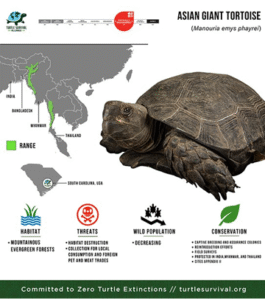
Why in News
-
Ten critically endangered Asian giant tortoises were reintroduced into the Zeliang Community Reserve, Nagaland.
-
This was a joint initiative by the Nagaland Forest Department and the India Turtle Conservation Programme (ITCP) to revive the species in its native habitat.
About Asian Giant Tortoise Reintroduction in Nagaland
What It Is
-
Largest land tortoise in mainland Asia
-
Plays an important role in:
-
Seed dispersal
-
Soil turnover
-
Forest health maintenance
-
-
Scientific Name: Manouria emys
Habitat
-
Found in tropical and subtropical forests of:
-
-
India
-
Bangladesh
-
Myanmar
-
Thailand
-
Malaysia
-
Indonesia
-
-
Preferred Habitat:
-
-
Dense, moist lowland and hill forests
-
Areas with abundant leaf litter and undergrowth
-
-
In India:
-
-
Historically widespread in Northeast India
-
Nagaland
-
Arunachal Pradesh
-
-
Conservation Status
-
IUCN Red List: Critically Endangered
-
Indian Wildlife Protection Act, 1972: Listed under Schedule IV
Key Features
-
Physical Characteristics:
-
-
Size: Up to 60 cm long
-
Weight: Over 35 kg
-
Shell: Dark brown to black, heavily domed with growth rings
-
Limbs: Thick, scaly forelimbs with elephant-like feet (used for digging)
-
Head: Flattened with sharp beak for tearing vegetation
-
-
Biological Traits:
-
-
Longevity: Lives 80–100 years
-
Diet: Herbivorous
-
Eats leaves, fruits, mushrooms, decomposing plant matter
-
-
Reproduction:
-
Builds above-ground nests in leaf litter
-
Females guard nests (a rare trait among tortoises)
-
-
Activity:
-
Diurnal
-
Solitary
-
Thrives in humid conditions
-
-
Unique Features
-
Known as the “small elephant of the forest” due to its seed dispersal role
-
One of the few tortoise species that shows maternal care
-
Acts as a keystone species:
-
Its extinction can disrupt forest regeneration cycles
-
एशियाई विशाल कछुए:
समाचार में क्यों
-
दस गंभीर रूप से संकटग्रस्त एशियाई विशाल कछुओं को नागालैंड के ज़ेलियांग कम्युनिटी रिज़र्व में फिर से छोड़ा गया।
-
यह नागालैंड वन विभाग और इंडिया टर्टल कंज़र्वेशन प्रोग्राम (ITCP) की एक संयुक्त पहल थी, जिसका उद्देश्य प्रजाति को उसके प्राकृतिक आवास में पुनर्जीवित करना है।
नागालैंड में एशियाई विशाल कछुए का पुनःपरिचय
क्या है यह
-
मुख्यभूमि एशिया का सबसे बड़ा स्थलीय कछुआ
-
महत्वपूर्ण भूमिका निभाता है:
-
बीजों के फैलाव में
-
मिट्टी की खुदाई में
-
जंगल के स्वास्थ्य को बनाए रखने में
-
-
वैज्ञानिक नाम: Manouria emys
आवास
-
उष्णकटिबंधीय और उप-उष्णकटिबंधीय वनों में पाया जाता है:
-
-
भारत
-
बांग्लादेश
-
म्यांमार
-
थाईलैंड
-
मलेशिया
-
इंडोनेशिया
-
-
पसंदीदा आवास:
-
-
घने, नम निम्नभूमि और पहाड़ी वन
-
जहां पत्तियों की मोटी परत और नीचे की झाड़ियाँ होती हैं
-
-
भारत में:
-
-
ऐतिहासिक रूप से पूर्वोत्तर भारत में व्यापक रूप से पाया गया
-
नागालैंड
-
अरुणाचल प्रदेश
-
-
संरक्षण स्थिति
-
IUCN रेड लिस्ट: गंभीर रूप से संकटग्रस्त
-
भारतीय वन्यजीव संरक्षण अधिनियम, 1972: अनुसूची IV के अंतर्गत सूचीबद्ध
मुख्य विशेषताएँ
-
शारीरिक लक्षण:
-
-
आकार: 60 सेमी तक लंबा
-
वजन: 35 किलोग्राम से अधिक
-
खोल: गहरा भूरा से काला, ऊपर से गुंबद जैसा और वृद्धि चक्रों के साथ
-
अंग: मोटे, पपड़ीदार अगले पैर, हाथी जैसे पैर (खोदाई के लिए)
-
सिर: चपटा और नुकीली चोंच जैसी बनावट (वनस्पति फाड़ने के लिए)
-
-
जैविक गुण:
-
-
आयु: 80–100 वर्ष
-
आहार: शाकाहारी
-
पत्तियाँ, फल, मशरूम, सड़ी हुई वनस्पति खाता है
-
-
प्रजनन:
-
पत्तियों की परत में ज़मीन के ऊपर घोंसला बनाता है
-
मादा घोंसले की रक्षा करती है (कछुओं में यह दुर्लभ गुण है)
-
-
गतिविधि:
-
दिन में सक्रिय
-
अकेला रहने वाला
-
नम वातावरण में अच्छी तरह फलता-फूलता है
-
-
विशेष विशेषताएँ
-
“जंगल का छोटा हाथी” कहा जाता है बीज फैलाने की भूमिका के कारण
-
कुछ कछुआ प्रजातियों में से एक जो मातृ देखभाल दिखाती है
-
एक कीस्टोन प्रजाति के रूप में कार्य करता है:
-
इसके विलुप्त होने से जंगलों के पुनरुत्थान चक्र में बाधा आ सकती है
-




